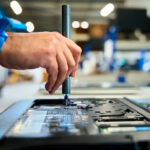Reducing the environmental impact of digital business
Recently, Windows announced its intention to disclose the energy consumption and greenhouse gas emissions of Windows 11. This is just one of many signals that the environmental impact of digital technology is becoming a global concern. This is all the more true for French companies, whose CSR (Corporate Social Responsibility) commitments require them to give particular thought to ESG (Environmental, Social and Governance) criteria. How can the ecological impact of IT equipment be explained? What can companies do to reduce it?
The environmental impact of digital technology: what are we talking about?
There are several stages to the lifecycle of IT equipment, with each stage having an impact on the environment.
The manufacture, use and end-of-life of electronic equipment all have ecological consequences. The manufacturing alone generates around 80% of the greenhouse gas (GHG) emissions in its entire life cycle. These multiple consequences embody what is known as the “environmental impact of digital technology“.
The growth of our daily digital uses therefore represents a real challenge for society. The digital sector accounts for more than 4% of the world’s carbon footprint. What accounts for these CO2 emissions? Mainly by the life cycles of terminals. That said, the use of datacentres and telecommunications networks also contribute, albeit to a lesser degree.
Companies that invest in their CSR (Corporate Social Responsibility) initiatives must therefore take these issues on board. Large groups, mid-sized companies and local authorities are directly concerned. Digital technology accounts for up to 20% of greenhouse gas emissions in some tech and service companies. The healthcare sector is also particularly concerned, accounting for 8% of France’s greenhouse gas emissions.
The life cycle of corporate digital equipment and its environmental impact
Is your organisation looking to reduce its carbon footprint, or more generally to improve its performance in terms of the E criterion of its ESG (Environmental, Social and Governance) criteria? You need to analyse each stage in the life cycle of the IT equipment you use to assess the environmental impact of the digital technology you employ.
Digital manufacturing and greenhouse gases
The manufacture of new digital equipment accounts for almost 80% of greenhouse gases over its entire life cycle. It has to be said that their production requires the consumption of large quantities of natural resources. Manufacturing a laptop, for example, requires 800 kg of raw materials such as fresh water, fossil fuels and minerals.
Among these, the extraction of rare metals requires energy-intensive processing. These metals are also non-renewable resources. Copper and nickel, for example, are likely to disappear within a few decades. This depletion of metal ores will mean that deposits will have to be dug deeper, which also has environmental implications.
Digital uses and pollution
Around 20% of the GHG emissions from digital equipment are due to its use. Your company’s carbon footprint is therefore partly due to the day-to-day use of IT equipment.
This environmental impact can be explained in particular by the energy consumed. Using equipment requires electricity and the use of data centres and telecommunications networks that consume a lot of energy.
The shortening lifespan of IT products is just as problematic. The technical and software obsolescence of hardware means that IT equipment has to be replaced too quickly. A real problem, given our persistent tendency to buy new rather than repair.
However, the organisation “Halte à l’obsolescence programmée” (HOP) estimates that extending the lifespan of IT equipment, combined with that of household appliances, textiles and furnishings, would reduce France’s greenhouse gas emissions by 77 million tonnes of CO2 per year.
End-of-life digital devices and non-recyclable materials
The end-of-life stage of digital products is not the most polluting part of the cycle. Nonetheless, its poor management can generate different types of pollution. Throwing away a digital product at the end of its life is tantamount to creating WEEE, or Waste Electrical and Electronic Equipment. WEEE is made up of polluting materials that are difficult to recycle. These include copper, aluminium, tin, lithium and mercury.
The majority of these components cannot be recycled from the WEEE collected. These materials will therefore be landfilled or incinerated. In both cases, these practices generate a form of pollution, if only because of the space they take up in landfill sites. Lithium-ion batteries, for example, are harmful to the environment if they are not properly treated.
To get round the ecological impact of digital technology at the end of its life, it’s important to remember that used or broken equipment is not waste. It can be reused, and in particular refurbished. It thus benefits from a second life cycle. Only irreparable equipment is true WEEE. However, even WEEE can be partially recycled.
How can we move towards a more responsible digital policy?
To reduce their company’s environmental impact, many organisations are making the transition to responsible digital technology. This transition is often part of a CSR approach. One of the first steps in this process may be to extend the lifespan of your digital equipment.
For example, you can adopt a systematic approach to repair rather than replacement. In this case, your Information Systems Department (ISD) is committed to preventive rather than curative maintenance. The aim: to extend the lifespan of your hardware. If your IT estate is too old and too diverse for in-house preventive maintenance to be possible, you can also call on a service provider specialising in IT estate maintenance.
Another CSR strategy based on digital ecology is to take back old equipment rather than throwing it away. At Codeo, for example, we work within a circular economy approach. We offer our customers solutions such as fleet maintenance, refurbishment and hardware rental to improve their sustainable development.
Buying refurbished equipment not only has ecological advantages. It’s also less expensive than buying new. What’s more, it’s an interesting way of maintaining the homogeneity of your IT equipment and preserving the habits of your team.
This is particularly true for business equipment such as barcode scanners, point-of-sale terminals and electronic payment terminals. On these devices, technologies change less quickly than on mobile devices such as smartphones or tablets. As a result, you are likely to find the same operational functions and the same constraints between different generations.Are you interested in the figures given here on the environmental impact of digital technology? Download our free guide to reducing your company’s digital footprint. Get access to recent statistics, expert advice and strategic guidelines to help you effectively advance your CSR policy.




